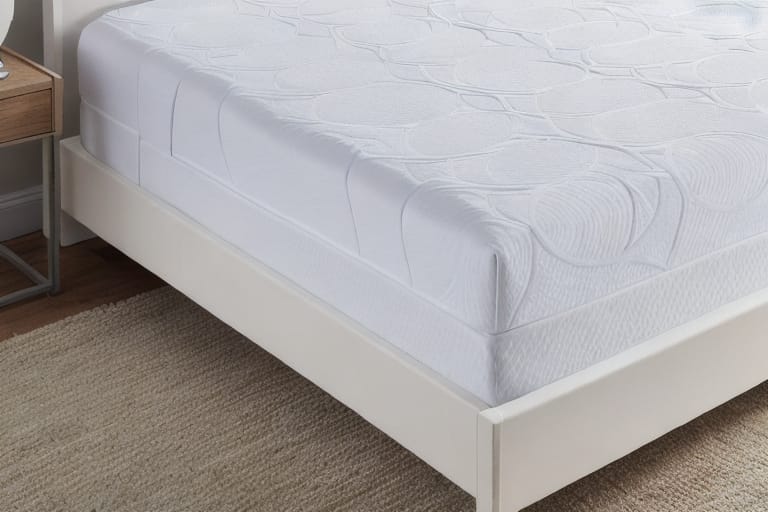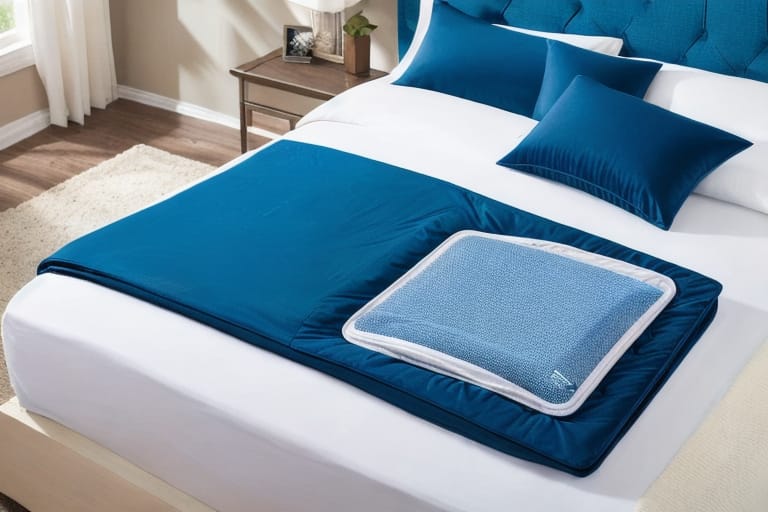Are you in the market for a new comforter? It can be overwhelming trying to navigate all the options – from down to down alternative to size to bedding thread count. But this guide breaks it down to the basics to help you understand exactly what a down comforter is and how to shop for the right one for your climate, sleeping habits, and more.
What are Down Comforters?
A down comforter refers to a duvet or quilt stuffed with light, fluffy down filling that provides warmth and comfort without too much weight. The down filling usually comes from ducks and geese. It is primarily made up of the delicate, fluffy clusters and insulating plumage underneath the exterior feathers. These clusters trap air to provide exceptional warmth and loft. Some of the key benefits include:
- Temperature regulation – down clusters provide excellent insulation properties to retain warmth while remaining breathable and moisture-wicking. This helps prevent overheating.
- Lightweight comfort – down filling is very lightweight and airy, allowing for a happily cushioned feeling without being heavy. This makes it ideal for providing cozy comfort all night.
- Durability – high-quality down comforters can last over a decade with proper care. They tend to be more durable than other filling options.
- Hypoallergenic options – some brands offer washable down comforters specifically treated to be hypoallergenic.
Types of Down Comforters
One of the first things to consider is whether you want a pure down comforter or a down alternative comforter.
Goose Down Comforters
Comforters filled solely with the fluffy plumage underneath goose feathers is considered “pure down”. Geese generally produce down clusters that have better insulating capabilities and more durability compared to duck down. Benefits include:
✔️ Superior warmth and loft ✔️ Long-lasting comfort ✔️ Higher fill power
But there are some considerations with goose down:
❌ More expensive than duck down or alternatives ❌ May provoke allergies without special hypoallergenic treatment ❌ Needs special handling to avoid damage
Down Alternative Comforters
Down alternative comforters use synthetic materials designed to mimic the qualities of natural down filling. Common materials include polyester, microfiber, rayon, or a proprietary branded fiber:
- Polyester – most widely used down alternative; inexpensive, hypoallergenic
- Microfiber – very fine, lightweight synthetic with down-like feel
- Rayon from bamboo – breathable and moisture-wicking but less loft
Alternatives match some benefits of natural down but have tradeoffs:
✔️ Affordable, hypoallergenic options
✔️ Easy care and machine washing ❌ Less warmth and durability over time ❌ May flatten and get lumpy
Make sure to compare both types of fill to determine what’s most important for your budget and preferences.
Factors in Choosing a Down Comforter
Beyond the type of fill, several other factors impact overall comfort and quality.
1. Fill Power & Warmth
Higher fill power means more loft and insulation value. Typical ranges include:
- Winter comforters – fill power of 600-650+ for maximum warmth
- All-season comforters – fill power around 500-550 provides adaptable warmth
- Summer comforters – fill power less than 500 for lightweight warmth
Match the fill power to the seasons you plan to use your down comforter the most.
2. Thread Count & Fabric
The outer shell encasing the down fill plays a role too. Thread count indicates the number of threads woven per square inch in the fabric. Options range from:
- 200-400 – polyester or cotton blends good for down alternatives
- 400-600 – mid-range cotton or Egyptian cotton ideal for many down comforters
- 600-1,000+ – premium ultra-soft long-staple cotton
Higher thread counts often correlate with more durability and comfort but also increase price. Consider how important shell texture is for your preference.
Choosing the Right Size Down Comforter
One common down comforter buying mistake is choosing the wrong size. Make sure your new cozy comforter will suitably cover your bed with the draping you prefer.
Standard Down Comforter Dimensions
This quick reference chart has average size dimensions for standard U.S. bed types. Pay special attention to the overhang proportions you want relative to your mattress and bed frame height.
For example, a Twin/Twin XL down comforter around 66″-72″ wide with an 86″-92” length allows for 10″-18” overhang space all around a standard twin mattress. But a King or California King’s massive width requires a comforter at least 110” wide to provide equal drape.
Aesthetic Considerations
Also decide whether you prefer:
- Tighter overhang for a neater, smoother look
- Plush billowy overhang for a fuller aesthetic
- Comforter length hitting just at the top of the mattress
- Extra long comforter length puddling onto the floor
Take bed frame height, box springs, and personal style into account when selecting dimensions.

Caring for a Down Comforter
To safely clean and store your down comforter for optimal longevity follow these tips:
1. Washing Methods
- Machine washable down offers easiest maintenance with front-loading washers using mild detergent
- Dry clean only down requires professional treatment to prevent damage
Use low agitation cycles and gentle soap to prevent tearing. Never overpack loads which can clump filling unevenly.
2. Proper Drying
Improper drying can irreparably damage down comforters. It is critical to:
- Completely air dry on low heat cycle if machine drying
- Reshape and redistribute filling evenly while damp
- Allow to fully dry before using or storing
These simple steps extend comforter lifespan for years of cozy warmth!
Where To Shop Top Down Comforter Brands
Ready to start browsing your dream down comforter? Here are two great places to begin your search:
1. Wayfair’s Duvets & Down Comforters
[Wayfair comforter product images]
Wayfair offers an extensive selection of down and down alternative comforters at excellent prices. Helpful filters let you narrow by size, price, fill power, color, and much more. Brands span affordable options like Linenspa to luxury designers like Mercer41. Expect frequent sales too!
➡️ Browse Wayfair Down Comforters
2. Tempur-Pedic Down Comforters
While pricier, Tempur-Pedic down comforters provide exceptional quality and design meant to pair beautifully with their mattresses. They uniquely construct their comforters in precise dimensions to align perfectly with specific mattress sizes. Their proprietary downs encase each fiber in a hypoallergenic membrane while retaining that sought-after fluffiness. For those wanting that seamless, perfectly made bed look this brand excels.
➡️ Browse Tempur-Pedic Down Comforters
Balancing Budget With Down Quality
With down comforter prices ranging anywhere from $50 to $2,000, it helps to define priorities to narrow options.
As shown in the chart above, higher fill powers, thread counts, sizes, and premium materials directly increase prices. More affordable options around $150 can still provide decent year-round warmth and comfort. Values between $200-400 balance quality and cost for most shoppers with mid-tier options. And luxury designer down comforters with 1000-thread count Egyptian cotton shells and 700+ fill power down exceed $500+.
Focus first on the fill power warmth needed for your climate. Then weigh shell fabric preferences against costs to pinpoint the best balance of value for your budget.
Sustainability & Ethical Sourcing Matters
An increasing number of consumers prioritize sustainability and humane animal treatment in their purchases. Fortunately, many down suppliers and comforter brands now focus on ethical down sourcing and manufacturing practices.
When comparing products, look for certifications like:
- Responsible Down Standard (RDS) – guarantees humane treatment of geese and ducks
- Global TDS – tracks and audits supply chains for responsible practices
- OEKO-TEX – ensures processing free of harmful chemicals
- GREENGUARD Gold – verifies low emissions production safe for sensitive individuals
Choosing bands adhering to such standards helps reassure you are supporting fair labor conditions and animal welfare.

Ready To Find Your Perfect Down Comforter?
We hope this down comforter buyer’s guide gave you the answers needed to make an informed, confident decision tailored exactly for your needs.
Here are a few key takeaways as you start shopping:
- Match insulation value (fill power) to your climate
- Prioritize the size, draping and bed style you prefer
- Balance shell fabric thread count and softness with price point
- Carefully follow washing methods to maximize lifespan
- Consider social responsibility in production
Incorporating these factors as you browse will set you up to select your ideal down-filled warmth machine encouraging restful sleep for years to come. We wish you the very best in finding that perfect cozy comforter!
Frequently Asked Questions
What’s the difference between a duvet and comforter?
A duvet is a thin quilted blanket that goes inside a protective cover, while a comforter is thicker, usually tufted, and meant to be used on its own without a cover. But the terms are sometimes used interchangeably.
How do I know if a down comforter will keep me warm enough?
Pay attention to the fill power – higher numbers around 600-700+ provide better insulation. Also consider your room temperature – hot sleepers or warmer climates may only need light summer-weight comforters with lower fill.
Why are responsibly sourced down comforters better?
Responsible sourcing through certifications like RDS or Global TDS reassure consumers the down and feathers inside come from ethically treated geese and ducks. This prioritizes fowl welfare as an important aspect of production.
What’s the benefit of baffle box construction?
Baffle boxes in down comforters help compartments of fill from shifting around inside. This provides consistent distribution of the fluffy insulation and prevents cold spots from developing.
How often should I replace my down comforter?
With proper maintenance like gentle machine washing and air drying, a quality down comforter should last over a decade. But if you notice fill clumping, flattened spots, damage from improper drying, tears, or stains, it may be time to replace an aging comforter sooner for optimal warmth and comfort.








